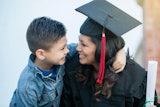While the number of exchange visas for international students and professors is up overall, the post-Sept. 11 decline continues for many majority-Muslim countries.
Last November, the U.S. Department of State heralded a record high number of visas issued to international students and exchange visitors.
A report by the Institute of International Education (IIE) on international students at U.S. colleges and universities confirmed that the number of student visas issued reached an “all-time high” for the 2007-08 academic year. The message was clear: International study in the United States, which dropped precipitously after the attacks of Sept. 11, 2001 was back.
International student enrollment at U.S. colleges and universities had seen constant growth most every year in the past quarter-century — with a glaring exception after the Sept. 11, 2001 terrorist attacks, when enrollment dropped three years in a row, according to numbers in IIE’s “Open Doors Report on International Student Exchange.”
In the 1983-1984 academic year, there were 338,894 international students in U.S. higher education, according to the report. That peaked at 586,323 in the 2002-2003 academic year that began the year after the Sept. 11 attacks — and dropped for three straight years afterward. It was only in the 2007-2008 academic year that international student numbers in the United States rebounded to a record number — 623,805 — exceeding its previous peak.
But a Diverse analysis of international student and exchange visitor visas found that those numbers have not rebounded from pre-Sept. 11 levels for the majority of the 25 North African and Asian nations that received extra scrutiny after the attacks.
At a time when the overall numbers for foreign study in the United States are soaring — up 26 percent from the year preceding the terrorist attacks — the number of F, M, and J visas is down 2 percent for those nations. If J visas are excluded, the number of visas issued to students from those targeted nations is down by 15 percent. The J visa is for exchange visitors, including some students, professors and researchers, but is also issued to non-academics such as government visitors, au pairs and camp counselors. F visas are issued to full-time students, and M visas are for vocational students.
Signs of Improvement and Stalled Progress
In 2002, the U.S. Department of Justice launched the National Security Entry/Exit Registration System (NSEERS). It requires that certain foreign visitors from 25 nations report to immigration offices for the purposes of national security.
Most of those countries are majority-Muslim, targeted as “places where al-Qaeda or other terrorist organizations have been active or where the United States has other national security concerns,” according to the Department of Homeland Security. The controversial reregistration program was suspended in December 2003.
Dr. Allan Goodman, president and CEO of the IIE — a nonprofit that administers international study programs for businesses, foundations and government agencies, including the State Department — is not sure what role the NSEERS program has had on the still-lagging number of visas issued to students from the 25 nations. But Goodman says the government’s post-Sept. 11 approach to international students has improved.
“I think the United States has fixed its system, and its system is now understandable globally, and students know they can get a student visa. It takes a little longer. They have to answer more questions. They have to have an interview,” says Goodman. “Globally, for international education, the world is still in a period of balancing open doors and national security. The United States may be ahead of other countries, because we had 9/11.”
A few NSEERS nations have actually seen the number of their student and exchange visitor visas increased significantly. The U.S. government issued hundreds more visas in the 2008 budget year to visitors from Iraq and Afghanistan than in 2001. Visitors from Libya, which recently normalized relations with the United States, received 1,806 more of those visas than in 2001. Saudi Arabia experienced the largest increase of the NSEERS nations — 3,702 more visas than in 2001.
Saudi Arabia’s rebound is striking. The number of Saudi students studying in the United States dropped by more than 2,500 in the years immediately after Sept. 11. Saudi King Abdullah’s 2005 visit with President George W. Bush helped reverse the losses by launching a Saudi scholarship program with streamlined U.S. visas for its students.
However, that’s not the case for most NSEERS nations.
In 2008, 16 of the 25 countries still are seeing fewer student and exchange visitor visas than they did in 2001. That’s hundreds fewer for students from Bangladesh, Egypt, Morocco and Lebanon — and thousands fewer for students from Indonesia and Pakistan. Many attribute that to added scrutiny of visa applications after Sept. 11.
“Although there is a lot of desire among the Pakistani students (to study in the United States), the process is such that it takes so long you can’t hold admission indefinitely,” says Faqir Syed Asif Hussain, a minister in the Pakistani embassy in Washington, D.C. “If a university accepts somebody for enrollment, the authorities need to grant the visas. There’s a need to expedite that process.”
Hussain believes that checking names against terrorist lists is creating delays. The State Department did not respond to repeated requests for comment.
Other Obstacles for Entry
Totok Suprayitno, education attaché for Indonesia’s embassy in Washington, D.C., says the Asian economic crisis of the late 1990s prompted a decrease in Indonesians studying in the United States, and Sept. 11 accelerated the decline. In 2008, the State Department issued 2,587 fewer student and exchange visitor visas to Indonesians than it did in 2001. In the 2007-08 school year, 7,692 Indonesians were studying here — about 4,000 fewer than in 2000-2001.
“Many people believe the major cause of the decline is because of the visa issues,” Suprayitno says. “To get a scholarship or (university) commitment, someone has to have a certainty whether the prospective student holds a visa or not. When the processing of the visa takes too long, the university will cancel. In some cases, also, the visas are being rejected.”
The IIE, dismayed by the drop in Indonesians studying in the United States, hosted a trip to Indonesia.
“We took a delegation of college and university presidents there last summer, partly because we were worried the numbers were going down,” says Goodman of the IIE. “It turned out that visas weren’t the reason they were going down. It was TOEFL.”
A stringent minimum score for the Test of English as a Foreign Language at U.S. schools, says Goodman, prompted many Indonesian students to go elsewhere.
“Indonesians don’t like to sit for those exams, and when the Australian education abroad unit said, ‘You could come to Australia and take the test when you get there,’ waves of Indonesians went to Australia,” Goodman says.
Suprayitno agrees that tougher TOEFL standards play a role but says U.S. delays are still the first obstacle for Indonesian students. He adds that it makes other countries with English-language programs — Australia, Japan, the United Kingdom — more attractive.
“I think both countries [the U.S. and Indonesia] need to find ways to get it back to the peak level,” Suprayitno says. “The majority of our leaders now are graduating from U.S. and European schools. They have a positive perspective about your country, a broader mindset. This not only benefits our country but is beneficial for the United States in the future.”
Robert O’Neil, director of the University of Virginia’s Thomas Jefferson Center for the Protection of Free Expression, says it is difficult to know where to place the blame for the low visa numbers from NSEERS nations.
“We don’t know to what extent U.S. policy is responsible or to what extent it largely is disenchantment of scholars from those countries,” O’Neil says. “Maybe it’s such a hassle that eventually it’s not worth it.”
O’Neil says it is a positive sign that numbers are up overall. In a few NSEERS nations, says O’Neil, “Things could have remained substantially depressed across the board … The federal government has done a commendable job over the last four years or so to try to facilitate the process to allow longer periods for which foreign students can stay before returning. I give the government at least a B+ in this area. I would not say the same about the treatment of visiting scholars.”
Government ‘Inhospitality’
The American Association of University Professors joined an unsuccessful lawsuit to challenge the U.S. government’s exclusion of Swiss scholar Dr. Tariq Ramadan. The government denied Ramadan’s visa in 2004, preventing him from accepting a position at the University of Notre Dame. The American Civil Liberties Union and the AAUP claimed the U.S. government excluded the Oxford University professor because it disagreed with his political views.
The government cited contributions Ramadan made to charities that provide aid to Palestinians — and alleged those groups donated to Hamas, deemed a terrorist organization by the U.S. government.
“There are a few other cases of people stopped at the border, or a case of one sent back, but Ramadan is the most extreme example of inhospitability to a foreign visitor,” says O’Neil, who chairs AAUP’s Special Committee on Academic Freedom and National Security in a Time of Crisis. “One of the heartening signs is that some institutions really have fought back and protected foreign visitors.”
O’Neil also cites the University of Nebraska-Lincoln’s successful pushback on government efforts to exclude Bolivian scholar Dr. Waskar Ari. O’Neil says several universities have stood up to FBI agents and refused to identify their Muslim students for questioning after the Sept. 11 attacks.
The future projections for the NSEERS nations are still mixed.
Last year showed signs of a possible end to the steady drop in Indonesian students in the United States that had occurred since the 2001-2002 academic year. IIE’s annual Open Doors study showed a slight increase in the number of Indonesians studying in the United States for the 2007-2008 school year. That was 354 more than the prior school year, the worst year since Sept. 11 for Indonesian students in the United States.
But Pakistan’s declines were not abated. Pakistani student numbers continued their annual post-Sept. 11 drops in the 2007-08 school year. The IIE survey showed that 5,345 Pakistani students were studying in the United States that year — 3,299 less than in the 2001-02 school year.
Hussain, the Pakistani minister in Washington, expresses hope that a bill sponsored by Senate Foreign Relations Committee Chairman John Kerry, D-Mass., and the panel’s ranking Republican, Sen. Richard Lugar, R-Ind., will help turn around the decline in Pakistani students in the United States.
The bill, recently introduced to reflect President Barack Obama’s interests in the region, would triple non-military U.S. aid to Pakistan to $1.5 billion a year. Among the U.S. policies toward Pakistan mentioned in the bill is an effort “to expand people-to-people engagement between the United States and Pakistan, through increased educational, technical, and cultural exchanges and other methods.’’
“Education is one area which really is important to win the minds of the people,” Hussain says. “You give them new ideas, knowledge. So our expectation is and was that Pakistan should be given precedence in this regard — and this bill will provide a huge amount of assistance for that.”
© Copyright 2005 by DiverseEducation.com















